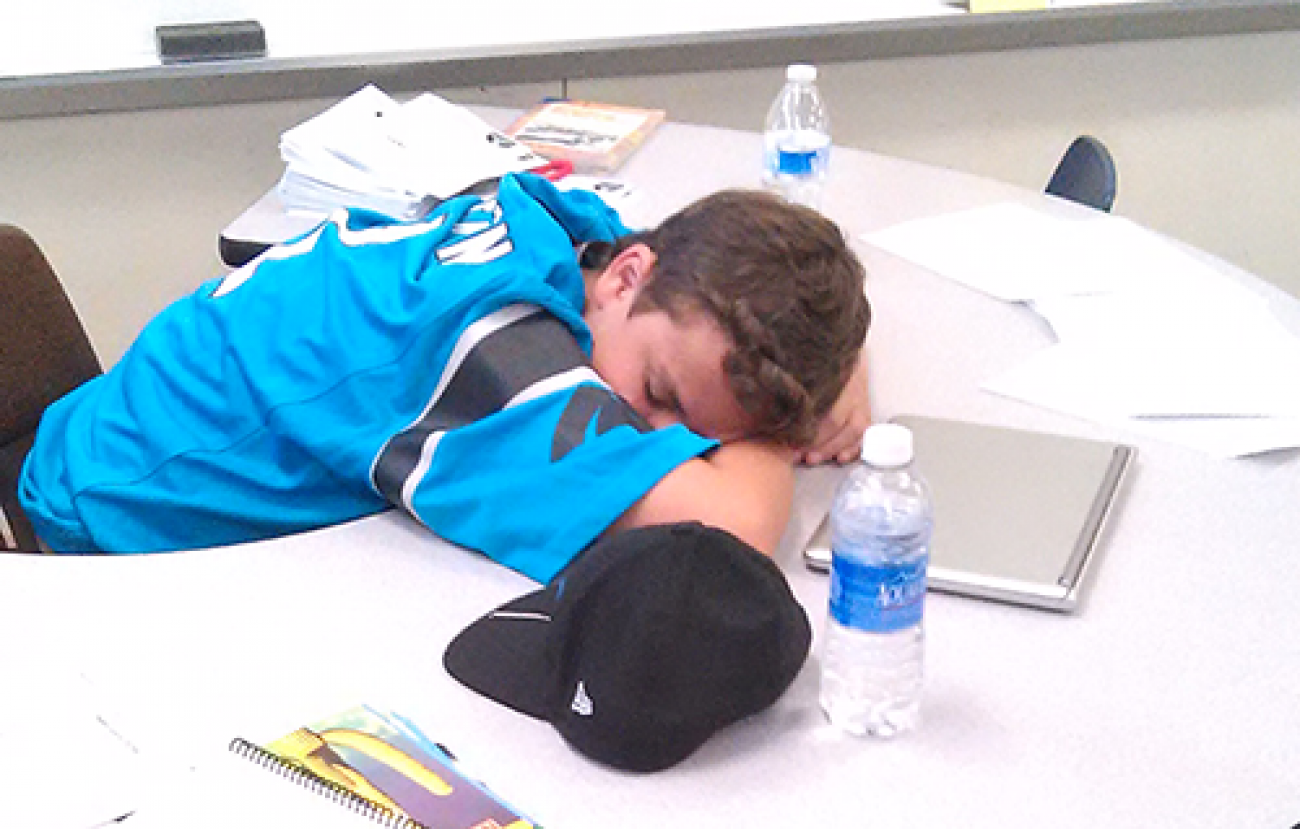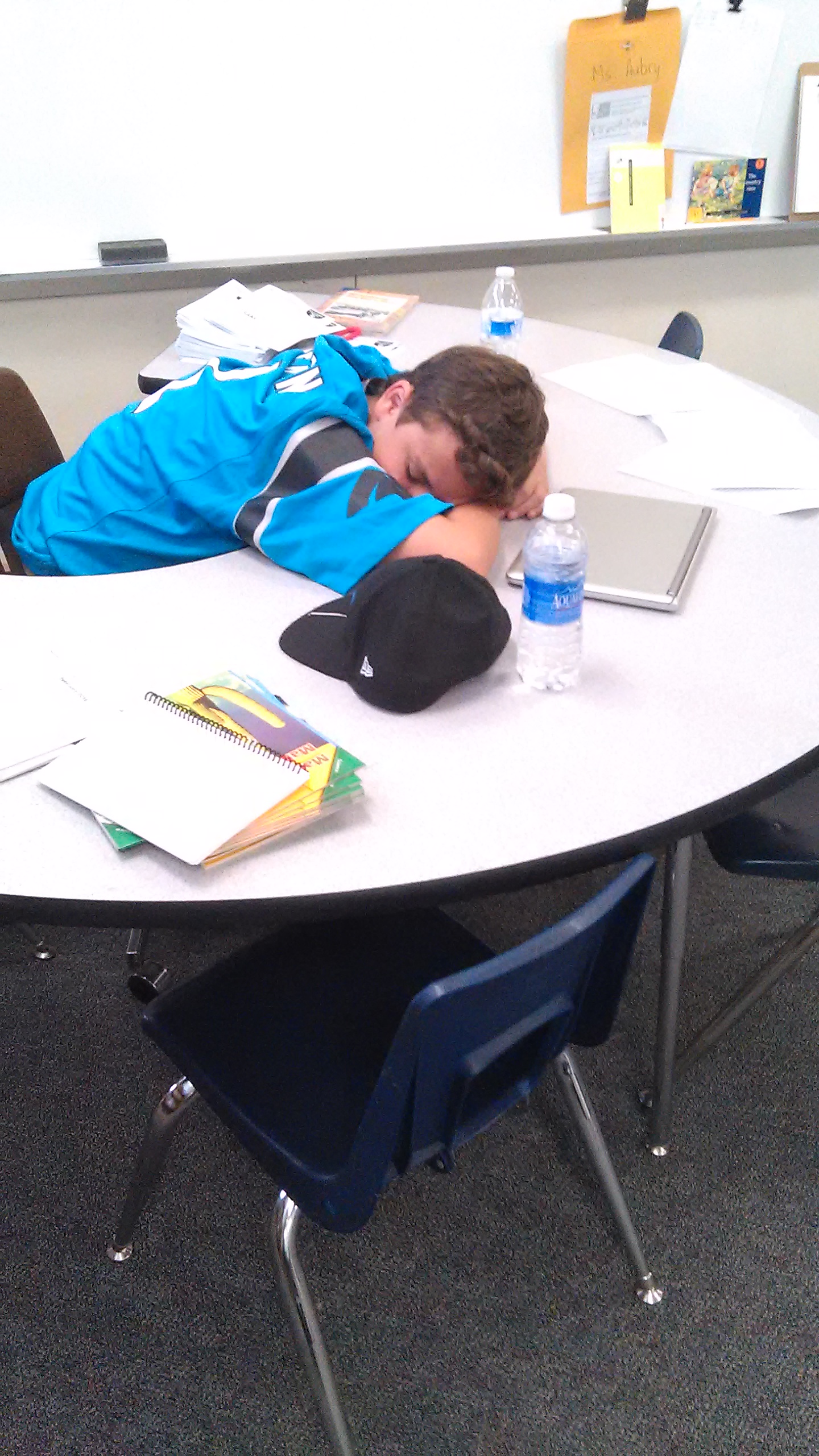Asleep at the desk: How school begins for many Michigan teens


Emily Driesenga needs more sleep.
“I try to get to bed earlier, but there are nights I have a lot of homework to do,” said Driesenga, 17, a junior at Ewen-Trout Creek High School, a rural Upper Peninsula district of 217 students about 100 miles west of Marquette. “I try to have a social life, too, texting or talking to my friends. Sometimes I'm up until midnight.”
That's just six hours of sleep until her 6 a.m. wakeup. It's also at least two hours less than what experts say teenage brains need to do well in school. Many days, she battles the first couple classes to keep her eyes open.
“I find myself dozing off sometimes,” Driesenga confessed.
So when she heard that Ewen-Trout Creek High School would move back the start of school next year from 8 a.m. to 8:35 a.m., it was welcome news.
“There are kids that do end up with their head on the desk,” Driesenga said. “I think our whole class was excited about the time switch.”
Evidence that's been building for decades says later start times for middle and high school students translate to better school performance, improved mental health and even fewer car crashes by teen drivers.
In recent years, high schools in California, Oklahoma, Georgia and New York have moved back their start times. This fall, the 53,000-student Seattle Public Schools will begin classes at 8:45 a.m. - a full 90 minutes after some Michigan high schoolers drag themselves into class.
But in Michigan, Ewen-Trout Creek is still something of an outlier: Most, Michigan K-12 districts still start high school at 8 a.m. or earlier, some as early as 7:10 a.m.
The Michigan Department of Education does not track school start times. Nor does the Michigan Association of School Boards or the Michigan Association of Secondary School Principals. But a survey by the U.S. Department of Education of middle schools and high schools in 2011-2012 found that Michigan had an average start time of 7:54 a.m., with between 75 percent and 100 percent of schools starting before 8 a.m. Average start times ranged from 7:40 a.m. in Louisiana to 8:33 a.m. in Alaska.
“This is one of a long list of things we do that is not best for kids,” said David Campbell superintendent of the Kalamazoo Regional Education Service Agency and former superintendent of Olivet Community Schools.
School leaders say they weigh the possibility of improved academic achievement against after-school sports and economics.
Many districts stagger their school start times so that one bus (and one bus driver) can drive upper-grade students on one route, and elementary students afterward, Campbell said.
“Double-bus routes save money because districts need fewer buses and bus drivers,” Campbell said.
When districts stagger start times between elementary and upper-grade schools, the upper grades generally have the earlier start times, Campbell said, because of safety and child-care issues. If start times are staggered, who do you want to be walking to a bus stop in the dark – elementary students or high schoolers?
“No one wants to see a second-grader waiting for a bus along a dark road at 6:30 in the morning,” Campbell said.
“When I was (superintendent) in Olivet, we’d talk about (start times) every year. We wanted to flip it, (so high schoolers would start later in the morning), but we’d always think, do you really want the young kids out at the end of the road in the dark?”
Related: What happened when one Minnesota school district let high schoolers sleep in
Jim Haskins, commissioner of the 50-school OK Conference in West Michigan, said pushing back the start of school would pose obvious conflicts with sporting events that start as early as 4 p.m. Say, for example, Rockford High School, 10 miles north of Grand Rapids, had a 4 p.m. track meet scheduled for East Kentwood High School south of Grand Rapids.
“You run into horrendous traffic that time of day,” Haskins said. “You have to allow for travel time.”
Haskins said sport schedules are set division by division within the conference, with each division agreeing on start times for events. If one school unilaterally moved back the start of school by an hour, that would all but assure some participants would have to be let out early.
“The principals do not like letting kids out of school early,” he said.
North of Grand Rapids, students at Sparta High School and Sparta Middle School commence school at 7:20 a.m. For some students who ride the bus, their pickup comes shortly after 6 a.m. That means in many cases these students are up at 5 a.m.
Superintendent Gordie Nickels says it's been this way for nearly 10 years, prior to a three-year period with an 8 a.m. start time because of a change in bus routes.
Nickels, who's been superintendent the past three years, said he can't recall anyone calling for a later start time.
“I don't think it's ever come up,” he said.
But he added that is aware of evidence that indicates teens learn better when they begin school later.
“I would welcome the discussion,” he said.
Indeed, a growing body of research says that adolescents with early start times arrive at school sleep deprived – in some cases, bordering on narcolepsy.
In 1998, sleep researcher Mary Carskadon of Brown University and several colleagues published a groundbreaking study of adolescents with a school start time of 7:20 a.m. In laboratory sleep tests, it found that many 10th graders on that schedule were “pathologically sleepy” by 8:30 a.m. Some had sleep patterns of narcoleptics.
Carskadon and other sleep experts say that's because of shifts in the adolescent internal biological clock, or circadian rhythm, causing teens to feel awake later at night than older adults. It also may be that this “night owl” state is heightened as teens tap away on cell phones or tablets deep into the evening, tricking their brain to sense wakeful daylight. That further delays the onset of the urge to sleep.
Their body clock tells them to sleep late next morning – but their school schedule says wake up.
“It's as if they get up and go to school but left their brains on the pillow at home,” Carskadon told Bridge Magazine.
Carskadon's findings square with a 2006 survey by the National Sleep Foundation that found 59 percent of sixth- through eighth-graders and 87 percent of high school students were getting less than the recommended 8.5 to 9.5 hours of sleep. Nearly 30 percent of students reported falling asleep at school at least once a week.
In 2014, researchers at the University of Minnesota published another study that looked at eight high schools in three states before and after they moved to later start times.
It reported that teens with later start times had higher attendance rates, better scores on some national achievement tests and, by and large, fewer car crashes. In schools that moved from a 7:35 a.m. start time to 8:55 a.m., it found a 70 percent reduction in car crashes among 16- to 18-year-olds.
The study concluded: “There are empirically-based outcomes for adolescents whenever their start time of their high school is moved to a later time – with the start time of 8:30 a.m. or later clearly showing the most positive results.”
That's a goal backed by the American Academy of Pediatrics, which advocates a start time of 8:30 a.m. or later for adolescents. It stated that would have “a wide range of potential benefits to students with regard to physical and mental health, safety and academic achievement.”
That standard is backed http://www.cdc.gov/media/releases/2015/p0806-school-sleep.html
by the Centers for Disease Control, which stated insufficient sleep “is associated with several health risks such as being overweight, drinking alcohol, smoking tobacco, and using drugs – as well as poor academic performance.”
In the Ewen-Trout Creek Schools, Superintendent Alan Tulppo needed no convincing of the merits of a later first bell.
“I am aware of the evidence. We're always looking at ways to improve student achievement,” Tulppo said.
The district surveyed parents about moving the school day back from 8 a.m., giving them three options: 8:15 a.m., 8:35 a.m. or 9 a.m.
The parents chose 8:35 a.m. - a move ratified by the school board in a unanimous vote at its April meeting. Tulppo said there was no opposition.
“It was more a dialogue than an argument,” Tulppo said.
Not surprisingly, Tulppo said: “The students were overwhelmingly in favor of it.”
That includes Jake Witt, 16, a sophomore at Ewen-Trout Creek High School.
Witt said there are school nights he's up until 1 a.m., unable to sleep because of a stressful day at school or homework. He confessed he'll turn to his cell phone when he can't sleep, a habit he realizes may make things worse.
He described what the next day after such night is like: “You are sitting there and your head is kind of bobbing. It makes you want to lay your head down and rest. But you don't want to miss out on the class.”
It's been a different story in the Ann Arbor Public Schools.
In 2012, a 14-person committee looked at moving back the start of school, before ultimately rejecting the idea. At the time, then-Deputy Superintendent for Instructional Services Alesia Flye said the committee was “not convinced the research suggests that if we make these huge adjustments, we will see huge academic gains.”
But the board revisited the issue in 2015, voting in March to make incremental changes in high school start times, moving it back by 15 minutes to 7:45 a.m. at one high school and by five minutes to 7:45 a.m. at two others. District administrators at the time said they would continue to look for ways to push start times to 8 a.m.
The move drew considerable online comment from parents, some faulting the board for taking such timid steps toward a later start time.
But there were doubts about moving the start of school back as well, including this comment: “The schools don't need to alter their schedules for our high school students. The students need to suck it up and manage themselves. After all, who will do this for them after they graduate from high school? 80% of life is just showing up.”
Brown University sleep researcher Carskadon told Bridge that entrenched skepticism about the science of sleep continues to impede widespread adoption of later school start times. She said the debate is often shaped by what's convenient for adults rather what's best for learning.
“This kind of, 'Suck it up, Buttercup' approach is really not well informed. It's not useful and it's not a public health strategy.
“The job of adolescents isn't just to show up. They have work to do. They need to learn. They need to grow their brains. This matters a lot. If they are wandering through school half awake, it isn't going to be successful.”
There are signs of a shift in this debate.
In 2015, after studying it for years, Seattle Public Schools became one of the largest districts in the nation to adopt a start time later than 8:30 a.m. Beginning in fall 2016, high schools and most middle schools in this district of about 53,000 students will commence first class at 8:45 a.m.
Pegi McAvoy, assistant superintendent of operations for the district, said the decision to roll back the start of school did not come easily. Prior to the 6-1 vote by the school board approving the move, a 30-member task for months studied start time proposals, finally recommending options close to what the board adopted.
Some parents objected. Others raised concerns about how it would affect sports and busing.
But by and large, McAvoy said, the later start time “is clearly what the community wanted to do.”
McAvoy said in the long run the winners in the time shift will be students.
“Clearly the adolescents are thinking this will be a winner. The high school teachers, in particular the first-hour teachers, think it will be a winner.”
In Grand Rapids, most high schools in the state's second largest district start around 7:30 a.m. Many of its middle schools start at 7:15 a.m.
In an ideal world, said district Superintendent Teresa Weatherall Neal, high school and middle school students might begin school later.
“I have looked at the research over the years,” Neal said. “I think it would be wonderful for kids.”
But Neal said moving back to the recommended 8:30 a.m. start time would likely mean many sports participants would miss the last hour of class.
“Missing an hour of class, that's quite a bit,” Neal said.
Neal said moving start times back would only work if all schools in the area adopted similar schedules, a subject she expected would come up in the next meeting of Kent County's 21 superintendents.
“I am sure this will be one of the topics we will talk about.”
See what new members are saying about why they donated to Bridge Michigan:
- “In order for this information to be accurate and unbiased it must be underwritten by its readers, not by special interests.” - Larry S.
- “Not many other media sources report on the topics Bridge does.” - Susan B.
- “Your journalism is outstanding and rare these days.” - Mark S.
If you want to ensure the future of nonpartisan, nonprofit Michigan journalism, please become a member today. You, too, will be asked why you donated and maybe we'll feature your quote next time!
 A student at a California high school with a 7:15 a.m. start time sleeps in class. (Courtesy of StartSchoolLater)
A student at a California high school with a 7:15 a.m. start time sleeps in class. (Courtesy of StartSchoolLater) Ewen-Trout Creek High School student Emily Driesenga: “I find myself dozing off sometimes.”
Ewen-Trout Creek High School student Emily Driesenga: “I find myself dozing off sometimes.” Sleep researcher Mary Carskadon of the effect of early start times on students: “It's as if they get up and go to school but left their brains on the pillow at home.” (Courtesy photo)
Sleep researcher Mary Carskadon of the effect of early start times on students: “It's as if they get up and go to school but left their brains on the pillow at home.” (Courtesy photo)